Concentric Split Aluminum with Silicon-Aluminum Nitride Annular Rings Resonators
Abstract
1. Introduction
2. Phononic Crystals Structure and Band Gaps
3. Analysis of Phononic Band Gaps
4. Device Analysis
5. Conclusions
Author Contributions
Funding
Acknowledgments
Conflicts of Interest
References
- Wang, H.; Lenz, H.; Szabo, A.; Bamberger, J.; Hanebeck, U.D. WLAN-Based Pedestrian Tracking Using Particle Filters and Low-Cost MEMS Sensors. In Proceedings of the 2007 4th Workshop on Positioning, Navigation and Communication, Hannover, Germany, 22 March 2007; pp. 1–7. [Google Scholar]
- Shin, S.H.; Park, C.G.; Kim, J.W.; Hong, H.S.; Lee, J.M. Adaptive Step Length Estimation Algorithm Using Low-Cost MEMS Inertial Sensors. In Proceedings of the 2007 IEEE Sensors Applications Symposium, San Diego, CA, USA, 6–8 February 2007; pp. 1–5. [Google Scholar]
- Cohen, A.; Zhang, G.; Tseng, F.-G.; Frodis, U.; Mansfeld, F.; Will, P. EFAB: Rapid, low-cost desktop micromachining of high aspect ratio true 3-D MEMS. In Proceedings of the Twelfth IEEE International Conference on Micro Electro Mechanical Systems (Cat. No.99CH36291), Orlando, FL, USA, 21 January 1999; pp. 244–251. [Google Scholar]
- Obuh, I.E.; Doychinov, V.; Steenson, D.P.; Akkaraekthalin, P.; Robertson, I.D.; Somjit, N. Low-Cost Microfabrication for MEMS Switches and Varactors. IEEE Trans. Components Packag. Manuf. Technol. 2018, 8, 1702–1710. [Google Scholar] [CrossRef]
- Breen, M.; Streyer, W.; Lu, R.; Gao, A.; Wasserman, D.; Gong, S. High speed mid-infrared detectors based on MEMS resonators and spectrally selective metamaterials. In Proceedings of the 2016 IEEE International Frequency Control Symposium (IFCS), New Orleans, LA, USA, 9–12 May 2016; pp. 1–6. [Google Scholar]
- Partridge, A.; Tabatabaei, S. Silicon MEMS oscillators for high speed digital systems. In Proceedings of the 2009 IEEE Hot Chips 21 Symposium (HCS), Stanford, CA, USA, 23–25 August 2009; pp. 1–25. [Google Scholar]
- Banerji, S.; Fernandez, D.; Madrenas, J. A Comprehensive High-Level Model for CMOS-MEMS Resonators. IEEE Sens. J. 2018, 18, 2632–2640. [Google Scholar] [CrossRef]
- Ambati, G.; Bell, J.F.W.; Sharp, J.C.K. In-plane vibrations of annular rings. J. Sound Vib. 1976, 47, 415–432. [Google Scholar] [CrossRef]
- Piazza, G.; Stephanou, P.J.; Pisano, A.P. Piezoelectric Aluminum Nitride Vibrating Contour-Mode MEMS Resonators. J. Microelectromech. Syst. 2006, 15, 1406–1418. [Google Scholar] [CrossRef]
- Zolfaghari, P.; Zadehsafari, M.; Akbari, A.; Ghavifekr, H.B. An acoustic piezoelectric ring-shape Lamb wave MEMS resonator. In Proceedings of the 2017 4th International Conference on Electrical and Electronic Engineering (ICEEE), Ankara, Turkey, 8–10 April 2017; pp. 23–27. [Google Scholar]
- Kasambe, P.V.; Asgaonkar, V.V.; Bangera, A.D.; Lokre, A.S.; Rathod, S.S.; Bhoir, D.V. Piezoelectric Lead Zirconate Titanate (PZT) Ring Shaped Contour-Mode MEMS Resonators. IOP Conf. Ser. Mater. Sci. Eng. 2018, 310, 012069. [Google Scholar] [CrossRef]
- Bijari, A.; Keshmiri, S.-H.; Babazadeh, F.; Bijari, A.; Keshmiri, S.-H.; Babazadeh, F. Nonlinear Modeling for Distortion Analysis in Silicon Bulk-Mode Ring Resonators. Micromachines 2012, 3, 582–603. [Google Scholar] [CrossRef]
- Yan, S.; Li, M.; Luo, L.; Ma, K.; Xue, C.; Zhang, W. Optimisation Design of Coupling Region Based on SOI Micro-Ring Resonator. Micromachines 2014, 6, 151–159. [Google Scholar] [CrossRef]
- Yen, M.H.; Feng, P.Y.; Lin, C.E.; Chen, C.C.; Chang, J.Y. Optimization of Pulley-Type Ring Resonator with Waveguide Offset. Micromachines 2018, 9, 226. [Google Scholar] [CrossRef]
- Zhou, X.; Xiao, D.; Li, Q.; Hu, Q.; Hou, Z.; He, K.; Chen, Z.; Zhao, C.; Wu, Y.; Seshia, A. Investigation on the Quality Factor Limit of the (111) Silicon Based Disk Resonator. Micromachines 2018, 9, 25. [Google Scholar] [CrossRef] [PubMed]
- Piazza, G.; Stephanou, P.J.; Pisano, A.P. Single-Chip Multiple-Frequency ALN MEMS Filters Based on Contour-Mode Piezoelectric Resonators. J. Microelectromech. Syst. 2007, 16, 319–328. [Google Scholar] [CrossRef]
- Siddiqi, M.W.U.; Lee, J.E.Y. AlN-on-Si MEMS resonator bounded by wide acoustic bandgap two-dimensional phononic crystal anchors. In Proceedings of the 2018 IEEE Micro Electro Mechanical Systems (MEMS), Belfast, UK, 21–25 January 2018; pp. 727–730. [Google Scholar]
- Siddiqi, M.W.U.; Lee, J.E.Y. Wide acoustic bandgap solid disk-shaped phononic crystal anchoring boundaries for enhancing quality factor in AlN-on-Si MEMS resonators. Micromachines 2018, 9, 413. [Google Scholar] [CrossRef]
- Feng, D.; Xu, D.; Wu, G.; Xiong, B.; Wang, Y. Phononic crystal strip based anchors for reducing anchor loss of micromechanical resonators. J. Appl. Phys. 2014, 115, 024503. [Google Scholar] [CrossRef]
- Wu, G.; Zhu, Y.; Merugu, S.; Wang, N.; Sun, C.; Gu, Y. GHz spurious mode free AlN lamb wave resonator with high figure of merit using one dimensional phononic crystal tethers. Appl. Phys. Lett. 2016, 109, 013506. [Google Scholar] [CrossRef]
- Rawat, U.; Nair, D.R.; Dasgupta, A. Piezoelectric-on-Silicon Array Resonators with Asymmetric Phononic Crystal Tethering. J. Microelectromech. Syst. 2017, 26, 773–781. [Google Scholar] [CrossRef]
- Ha, T.D.; Bao, J.F. Reducing anchor loss in thin-film aluminum nitride-on-diamond contour mode MEMS resonators with support tethers based on phononic crystal strip and reflector. Microsyst. Technol. 2016, 22, 791–800. [Google Scholar] [CrossRef]
- Awad, M.; Bao, F.; Bao, J.; Zhang, X. Cross-shaped PnC for anchor loss reduction of thin-film ALN-on-silicon high frequency MEMS resonator. In Proceedings of the 2018 IEEE MTT-S International Wireless Symposium (IWS), Chengdu, China, 6–10 May 2018; pp. 1–3. [Google Scholar]
- Miranda, E.J.P.; Santos, J.M.C.D. Evanescent Bloch waves and complex band structure in magnetoelectroelastic phononic crystals. Mech. Syst. Signal Process. 2018, 112, 280–304. [Google Scholar] [CrossRef]
- Manktelow, K.; Narisetti, R.K.; Leamy, M.J.; Ruzzene, M. Finite-element based perturbation analysis of wave propagation in nonlinear periodic structures. Mech. Syst. Signal Process. 2013, 39, 32–46. [Google Scholar] [CrossRef]
- Zhu, H.; Lee, J.E.-Y. AlN piezoelectric on silicon MEMS resonator with boosted Q using planar patterned phononic crystals on anchors. In Proceedings of the 2015 28th IEEE International Conference on Micro Electro Mechanical Systems (MEMS), Estoril, Portugal, 18–22 January 2015; pp. 797–800. [Google Scholar]
- Ardito, R.; Cremonesi, M.; D’Alessandro, L.; Frangi, A. Application of optimally-shaped phononic crystals to reduce anchor losses of MEMS resonators. In Proceedings of the 2016 IEEE International Ultrasonics Symposium (IUS), Tours, France, 18–21 September 2016; pp. 1–3. [Google Scholar]
- Guha, B.; Marsault, F.; Cadiz, F.; Morgenroth, L.; Ulin, V.; Berkovitz, V.; Lemaître, A.; Gomez, C.; Amo, A.; Combrié, S.; et al. Surface-enhanced gallium arsenide photonic resonator with quality factor of 6 × 106. Optica 2017, 4, 218. [Google Scholar] [CrossRef]
- Yablonovitch, E. Inhibited Spontaneous Emission in Solid-State Physics and Electronics. Phys. Rev. Lett. 1987, 58, 2059–2062. [Google Scholar] [CrossRef] [PubMed]
- Assouar, M.B.; Sun, J.-H.; Lin, F.-S.; Hsu, J.-C. Hybrid phononic crystal plates for lowering and widening acoustic band gaps. Ultrasonics 2014, 54, 2159–2164. [Google Scholar] [CrossRef]
- Jing-Fu, B.; Khan, M.A.; Fei-Hong, B. Phononic Crystal Resonators. In Phonons in Low Dimensional Structures; IntechOpen: London, UK, 2018. [Google Scholar]
- Hsu, F.-C.; Hsu, J.-C.; Huang, T.-C.; Wang, C.-H.; Chang, P. Design of lossless anchors for microacoustic-wave resonators utilizing phononic crystal strips. Appl. Phys. Lett. 2011, 98, 143505. [Google Scholar] [CrossRef]
- Lin, C.-M.; Hsu, J.-C.; Senesky, D.G.; Pisano, A.P. Anchor loss reduction in ALN Lamb wave resonators using phononic crystal strip tethers. In Proceedings of the 2014 IEEE International Frequency Control Symposium (FCS), Taipei, Taiwan, 12–22 May 2014; pp. 1–5. [Google Scholar]
- Ha, T.D.; Bao, J. A phononic crystal strip based on silicon for support tether applications in silicon-based MEMS resonators and effects of temperature and dopant on its band gap characteristics. AIP Adv. 2016, 6, 045211. [Google Scholar] [CrossRef]
- Nassar, H.; Chen, H.; Norris, A.N.; Huang, G.L. Quantization of band tilting in modulated phononic crystals. Phys. Rev. B 2018, 97, 014305. [Google Scholar] [CrossRef]
- Wang, S.; Popa, L.C.; Weinstein, D. GaN MEMS resonator using a folded phononic crystal structure. Proc. Solid-State Sens., Actuators, Microsyst. Workshop 2014, 1, 72–75. [Google Scholar]
- Ren, S.Y. Complete quantum confinement of one-dimensional Bloch waves. Phys. Rev. B 2001, 64, 035322. [Google Scholar] [CrossRef]
- Sause, M.G.R.; Hamstad, M.A. Numerical modeling of existing acoustic emission sensor absolute calibration approaches. Sens. Actuators A Phys. 2018, 269, 294–307. [Google Scholar] [CrossRef]
- Zou, K.; Ma, T.-X.; Wang, Y.-S. Investigation of complete bandgaps in a piezoelectric slab covered with periodically structured coatings. Ultrasonics 2016, 65, 268–276. [Google Scholar] [CrossRef]
- Rottenberg, X.; Jansen, R.; Tilmans, H.A.C. Phononic BandGap coupled Bulk Acoustic wave Resonators. In Proceedings of the 2012 IEEE 25th International Conference on Micro Electro Mechanical Systems (MEMS), Paris, France, 29 Janaury–2 February 2012; pp. 725–728. [Google Scholar]
- Delpero, T.; Schoenwald, S.; Zemp, A.; Bergamini, A. Structural engineering of three-dimensional phononic crystals. J. Sound Vib. 2016, 363, 156–165. [Google Scholar] [CrossRef]
- Babaee, S.; Wang, P.; Bertoldi, K. Three-dimensional adaptive soft phononic crystals. J. Appl. Phys. 2015, 117, 244903. [Google Scholar] [CrossRef]
- Pourabolghasem, R.; Mohammadi, S.; Eftekhar, A.A.; Khelif, A.; Adibi, A. Experimental evidence of high-frequency complete elastic bandgap in pillar-based phononic slabs. Appl. Phys. Lett. 2014, 105, 231908. [Google Scholar] [CrossRef]
- Gao, Z.; Fang, J.; Zhang, Y.; Jiang, L. Band structure research of a 2D honeycomb lattice phononic crystal. Int. J. Electrochem. Sci. 2013, 8, 7918–7925. [Google Scholar]
- Gruszka, K.; Nabiałek, M.; Szota, M. The influence of fill factor on the phononic crystal eigenfrequencies. Arch. Mater. Sci. Eng. 2014, 66, 74–80. [Google Scholar]
- Oltulu, O.; Mamedov, A.M.; Ozbay, E. Band gap structure of elliptic rods in water for a 2D phononic crystal. Appl. Phys. A 2017, 123, 212. [Google Scholar] [CrossRef]
- Gorisse, M.; Benchabane, S.; Teissier, G.; Billard, C.; Reinhardt, A.; Laude, V.; Defaÿ, E.; Aïd, M. Observation of band gaps in the gigahertz range and deaf bands in a hypersonic aluminum nitride phononic crystal slab. Appl. Phys. Lett. 2011, 98, 234103. [Google Scholar] [CrossRef]
- Hsiao, F.-L.; Khelif, A.; Moubchir, H.; Choujaa, A.; Chen, C.-C.; Laude, V. Complete band gaps and deaf bands of triangular and honeycomb water-steel phononic crystals. J. Appl. Phys. 2007, 101, 044903. [Google Scholar] [CrossRef]
- Shi, X.; Shi, D.; Qin, Z.; Wang, Q. In-Plane Vibration Analysis of Annular Plates with Arbitrary Boundary Conditions. Sci. World J. 2014, 2014, 653836. [Google Scholar] [CrossRef] [PubMed]
- Bashmal, S.; Bhat, R.; Rakheja, S. In-plane free vibration of circular annular disks. J. Sound Vib. 2009, 322, 216–226. [Google Scholar] [CrossRef]
- Bashmal, S.; Bhat, R.; Rakheja, S. Frequency Equations for the In-Plane Vibration of Circular Annular Disks. Adv. Acoust. Vib. 2010, 2010, 501902. [Google Scholar] [CrossRef]
- Siddiqi, M.W.U.; Tu, C.; Lee, J.E.-Y. Effect of mode order, resonator length, curvature, and electrode coverage on enhancing the performance of biconvex resonators. J. Micromech. Microeng. 2018, 28, 094002. [Google Scholar] [CrossRef]
- Khine, L.; Palaniapan, M.; Shao, L.; Wong, W.K. Characterization of SOI Lamé-mode square resonators. In Proceedings of the 2008 IEEE International Frequency Control Symposium, Honolulu, HI, USA, 19–21 May 2008; pp. 625–628. [Google Scholar]
- Hopcroft, M.A.; Nix, W.D.; Kenny, T.W. What is the Young’s Modulus of Silicon? J. Microelectromech. Syst. 2010, 19, 229–238. [Google Scholar] [CrossRef]
- Braginsky, V.B.; Mitrofanov, V.P.; Panov, V.I.; Krotkov, R. Systems with Small Dissipation. Am. J. Phys. 1987, 55, 1153–1154. [Google Scholar] [CrossRef]
- Zou, J.; Lin, C.-M.; Tang, G.; Pisano, A.P. High-Q Butterfly-Shaped AlN Lamb Wave Resonators. IEEE Electron Device Lett. 2017, 38, 1739–1742. [Google Scholar] [CrossRef]
- Chen, Y.-Y.; Lai, Y.-T.; Lin, C.-M. Finite element analysis of anchor loss in AlN Lamb wave resonators. In Proceedings of the 2014 IEEE International Frequency Control Symposium (FCS), Taipei, Taiwan, 19–22 May 2014; pp. 1–5. [Google Scholar]
- Chandorkar, S.A.; Agarwal, M.; Melamud, R.; Candler, R.N.; Goodson, K.E.; Kenny, T.W. Limits of quality factor in bulk-mode micromechanical resonators. In Proceedings of the 2008 IEEE 21st International Conference on Micro Electro Mechanical Systems, Wuhan, China, 13–17 January 2008; pp. 74–77. [Google Scholar]
- Frangi, A.; Cremonesi, M.; Jaakkola, A.; Pensala, T. Analysis of anchor and interface losses in piezoelectric MEMS resonators. Sens. Actuators A Phys. 2013, 190, 127–135. [Google Scholar] [CrossRef]
- Frangi, A.; Cremonesi, M.; Jaakkola, A.; Bathe, K. Optimization of MEMS Piezo-Resonators. Struct. Longev. 2012, 7, 129–134. [Google Scholar]
- Zou, J.; Lin, C.-M.; Pisano, A.P. Quality factor enhancement in Lamb wave resonators utilizing butterfly-shaped AlN plates. In Proceedings of the 2014 IEEE International Ultrasonics Symposium, Chicago, IL, USA, 3–6 September 2014; pp. 81–84. [Google Scholar]
- Zou, J.; Lin, C.-M.; Pisano, A.P. Anchor loss suppression using butterfly-shaped plates for AlN Lamb wave resonators. In Proceedings of the 2015 Joint Conference of the IEEE International Frequency Control Symposium & the European Frequency and Time Forum, Denver, CO, USA, 12–16 April 2015; pp. 432–435. [Google Scholar]
- Bindel, D.S.; Govindjee, S. Elastic PMLs for resonator anchor loss simulation. Int. J. Numer. Methods Eng. 2005, 64, 789–818. [Google Scholar] [CrossRef]
- Berenger, J.-P. A perfectly matched layer for the absorption of electromagnetic waves. J. Comput. Phys. 1994, 114, 185–200. [Google Scholar] [CrossRef]
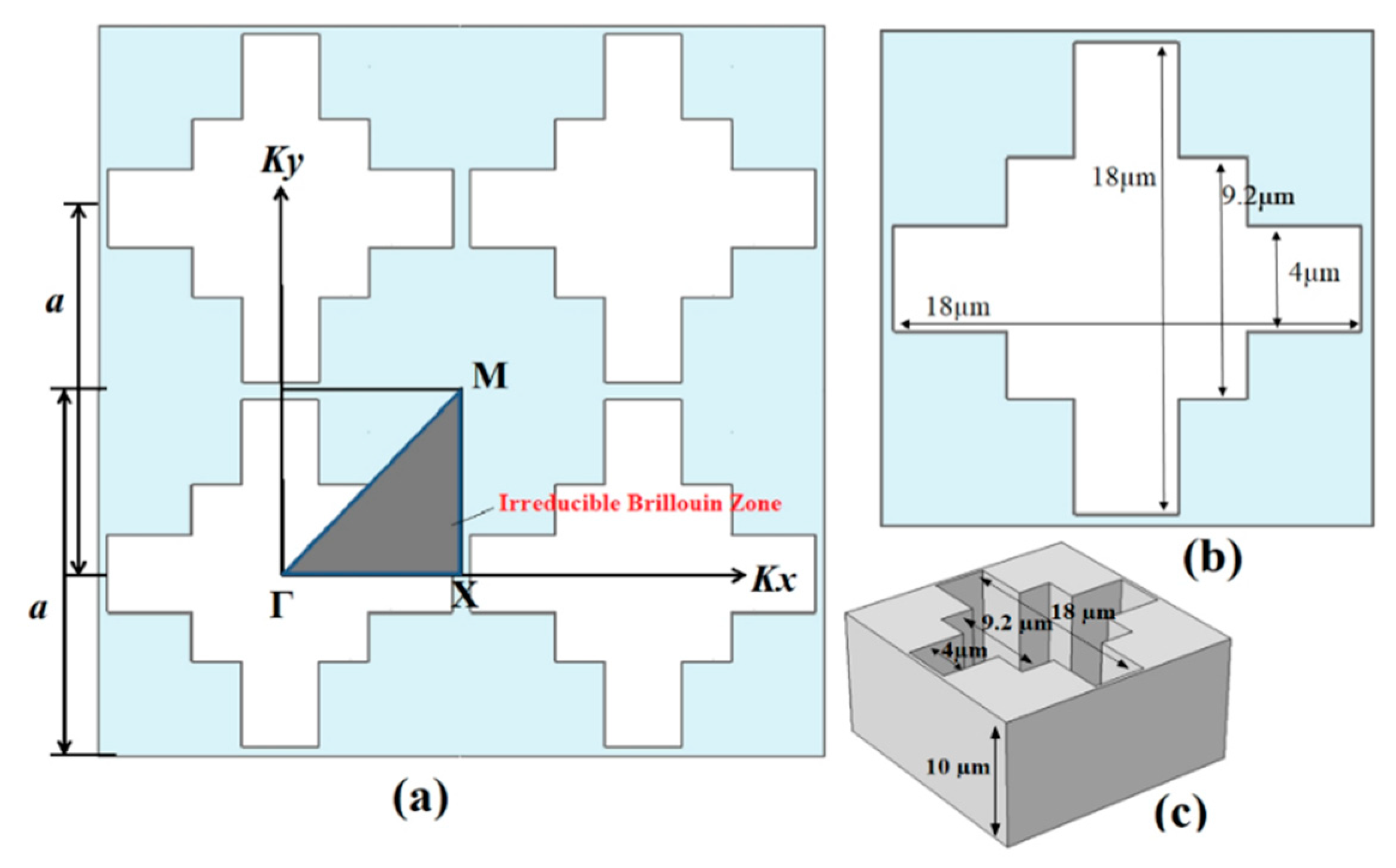
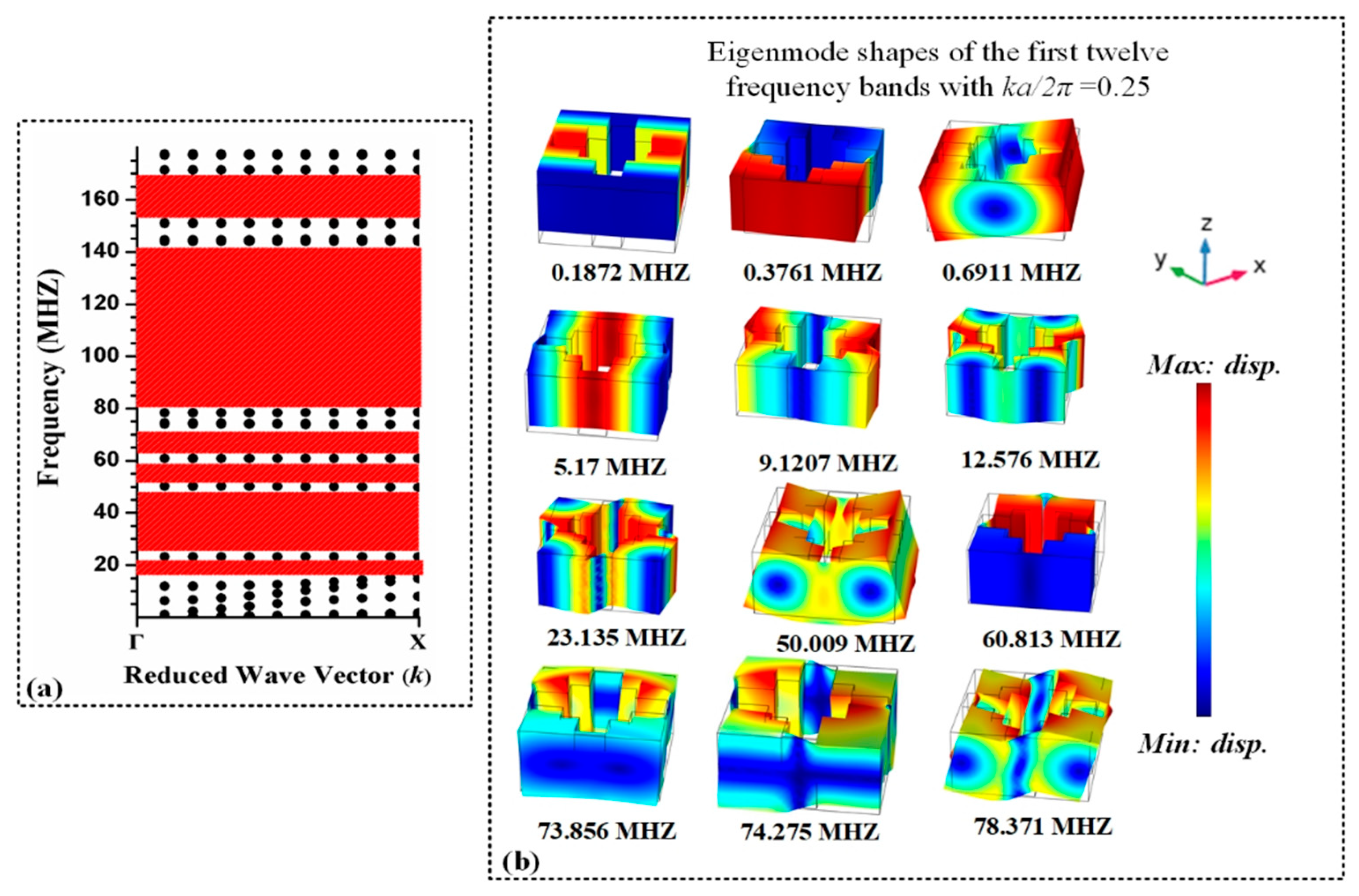
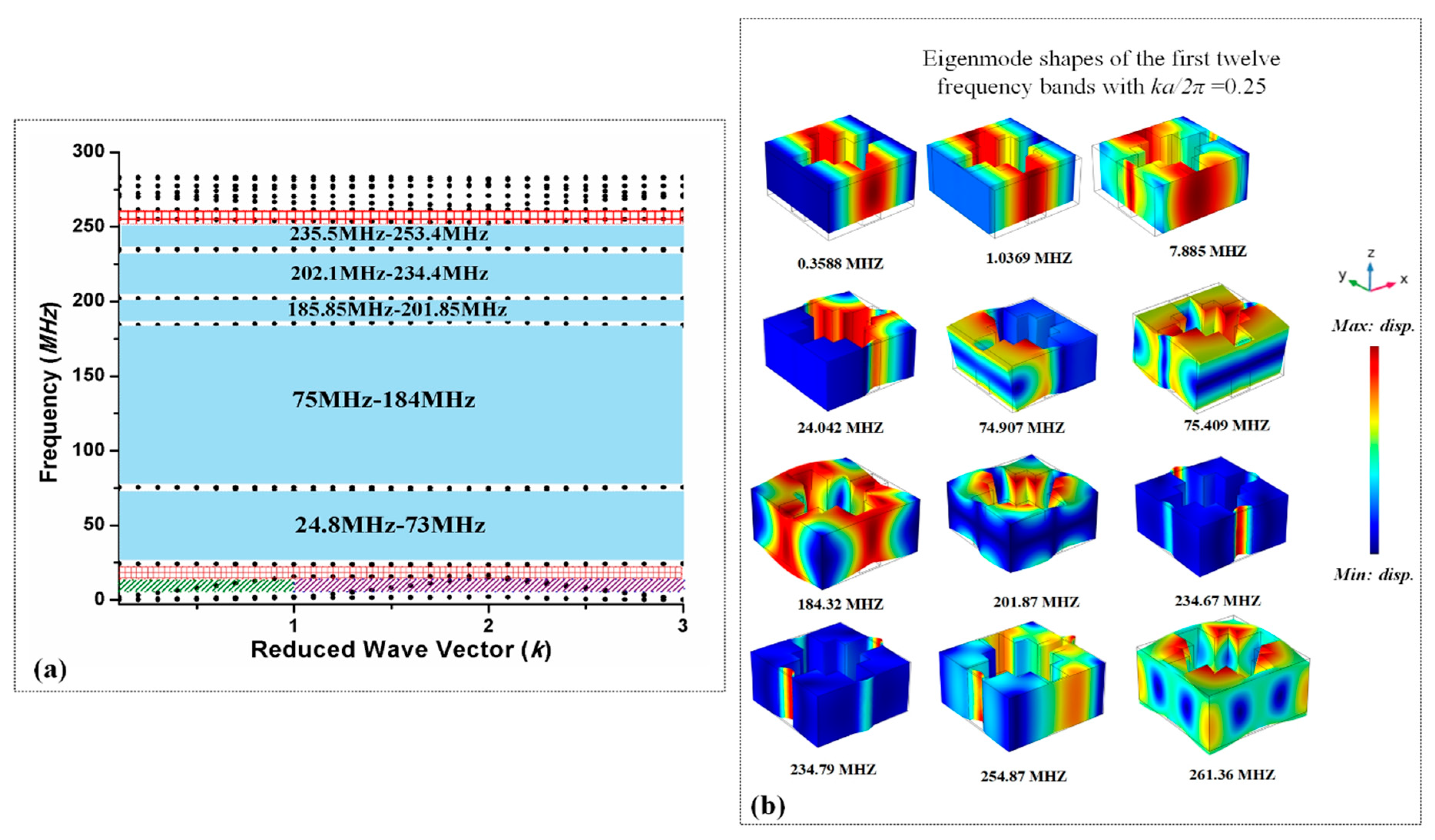
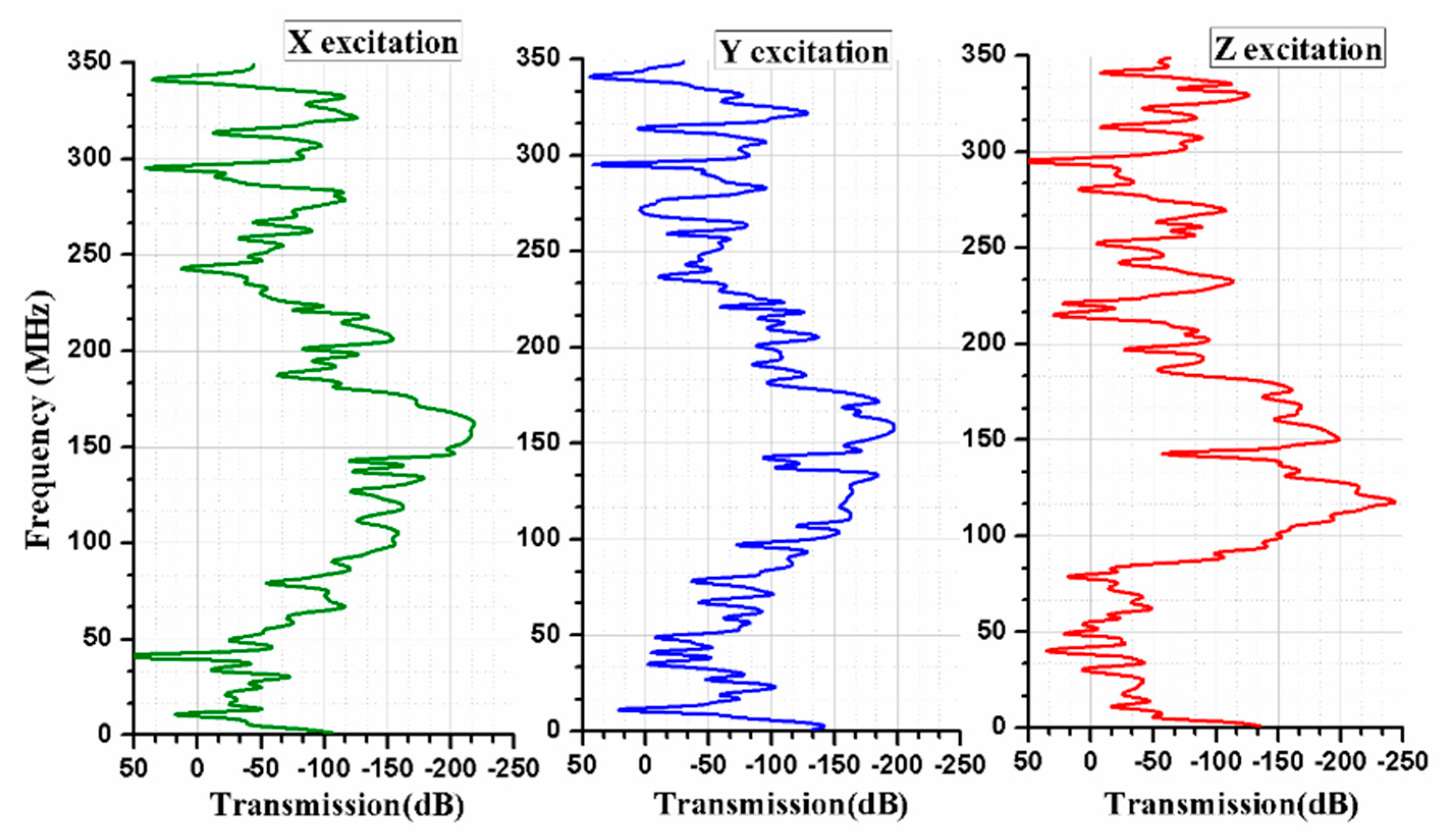
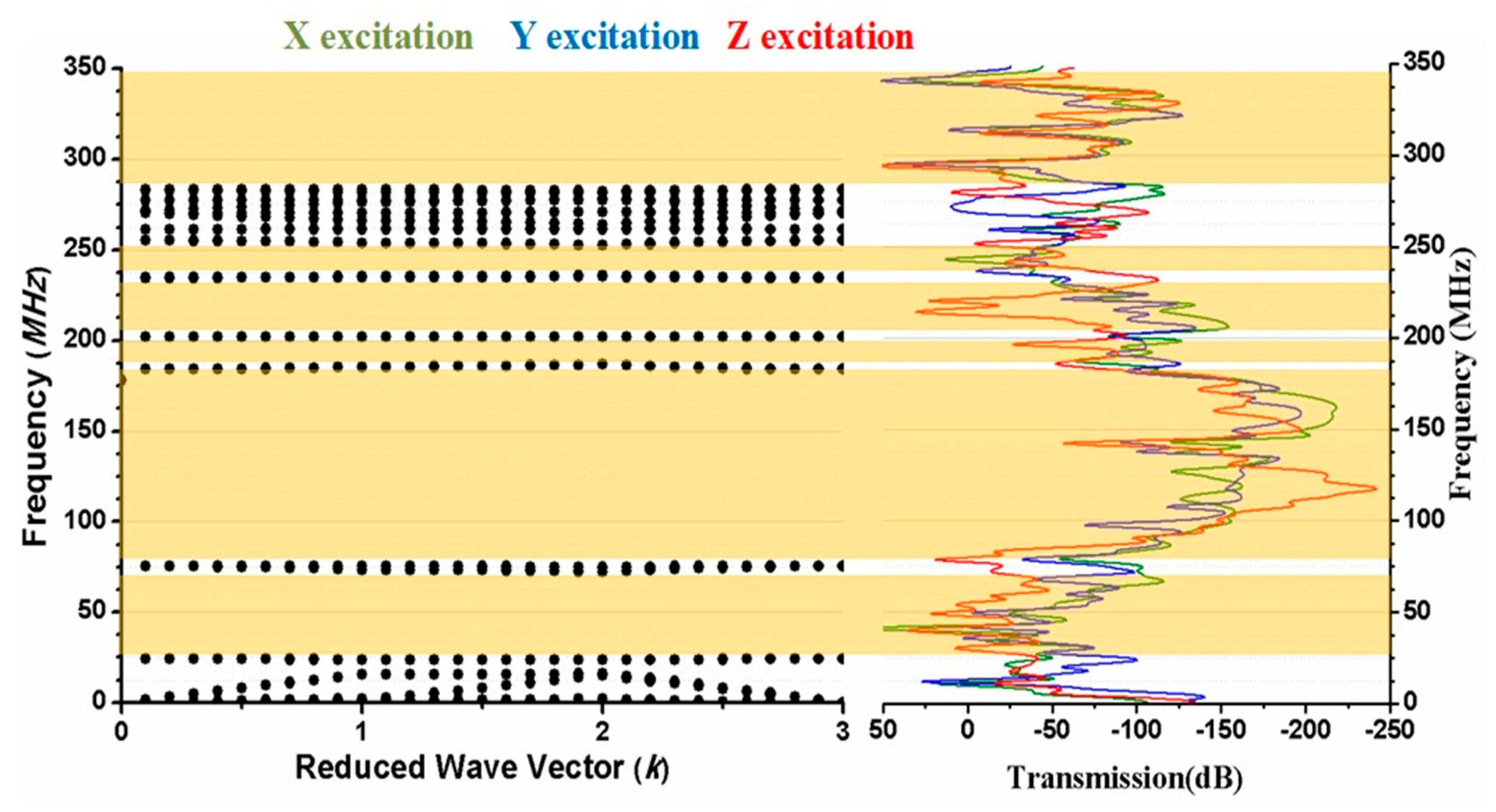
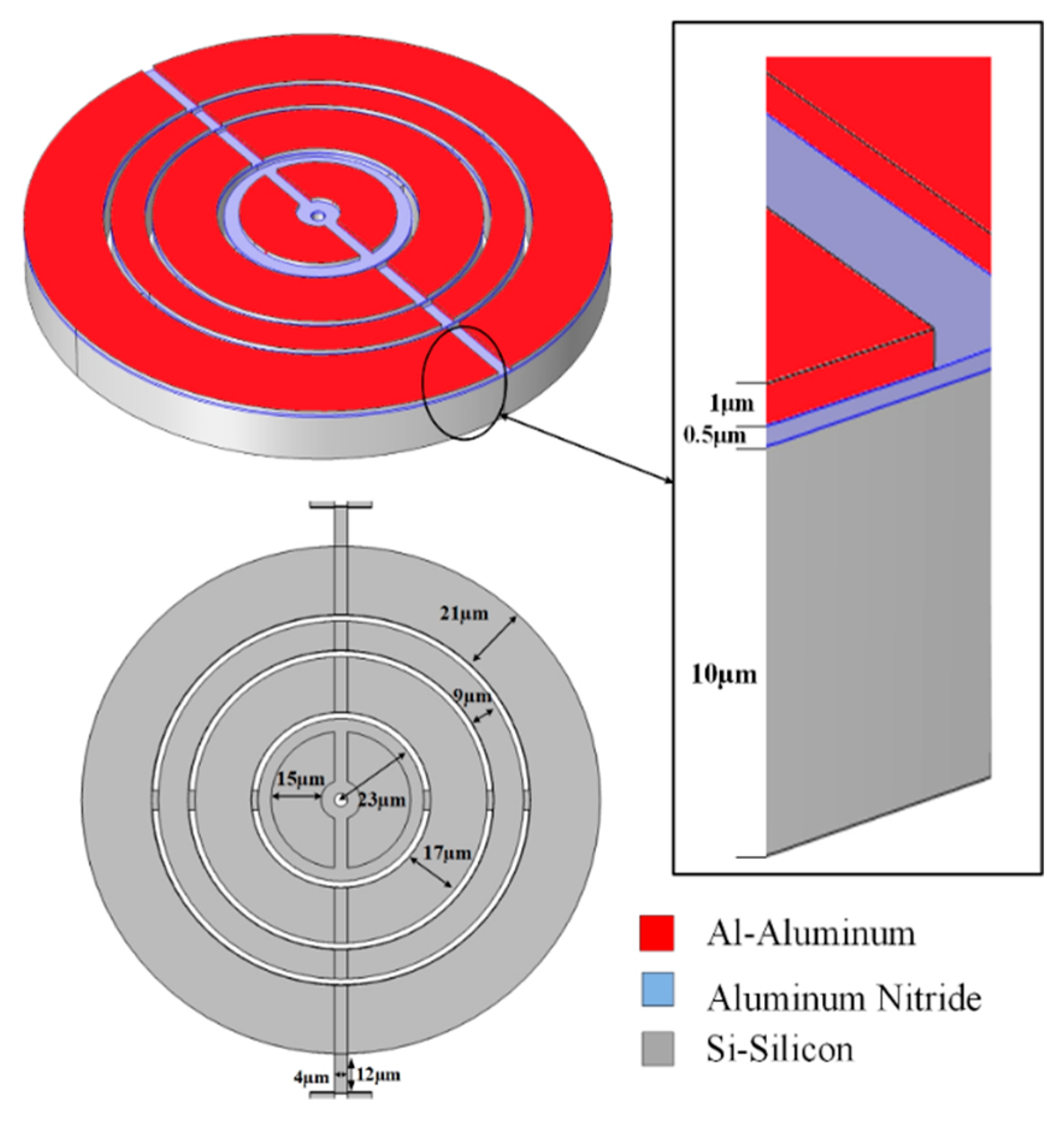
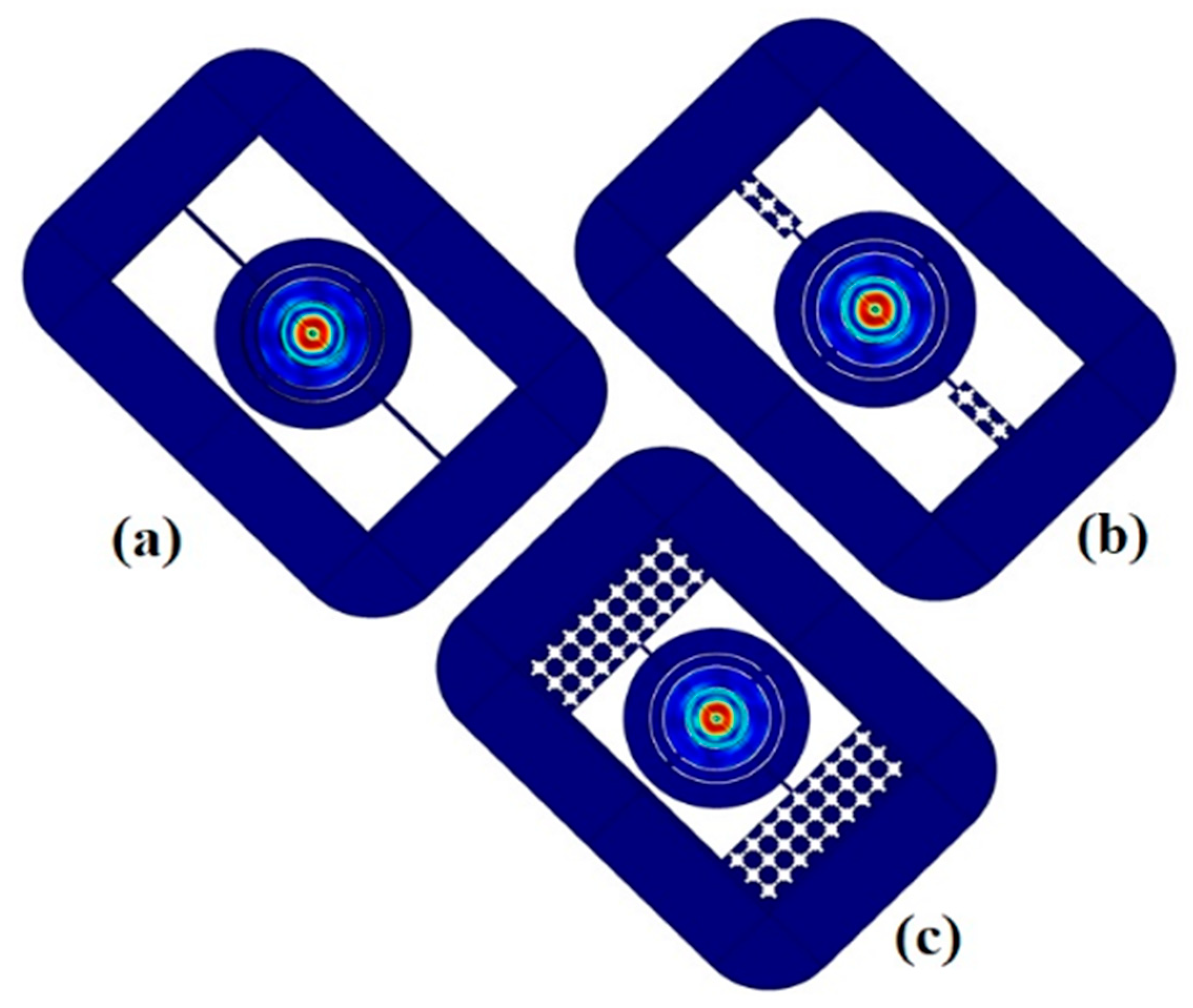
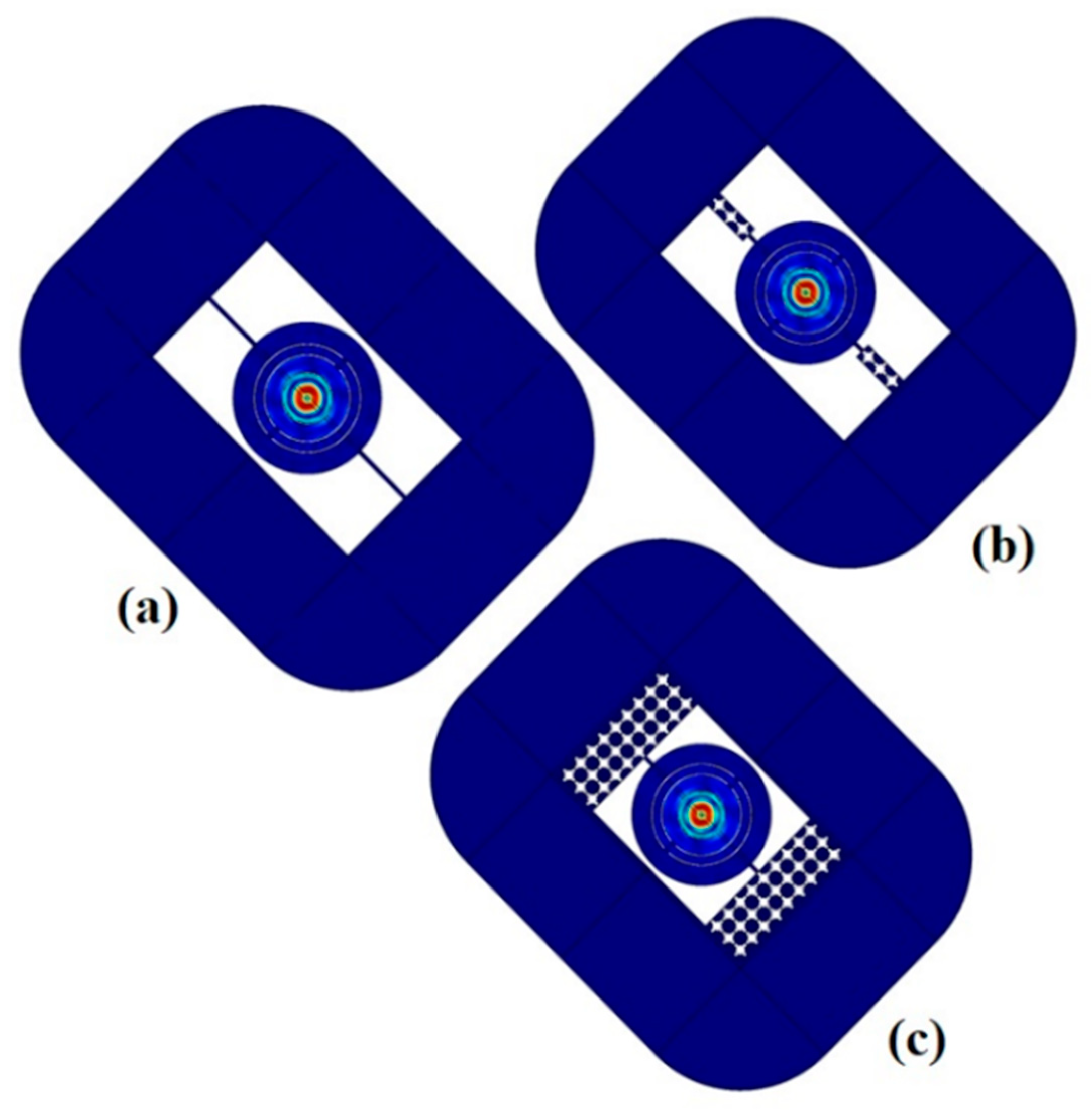
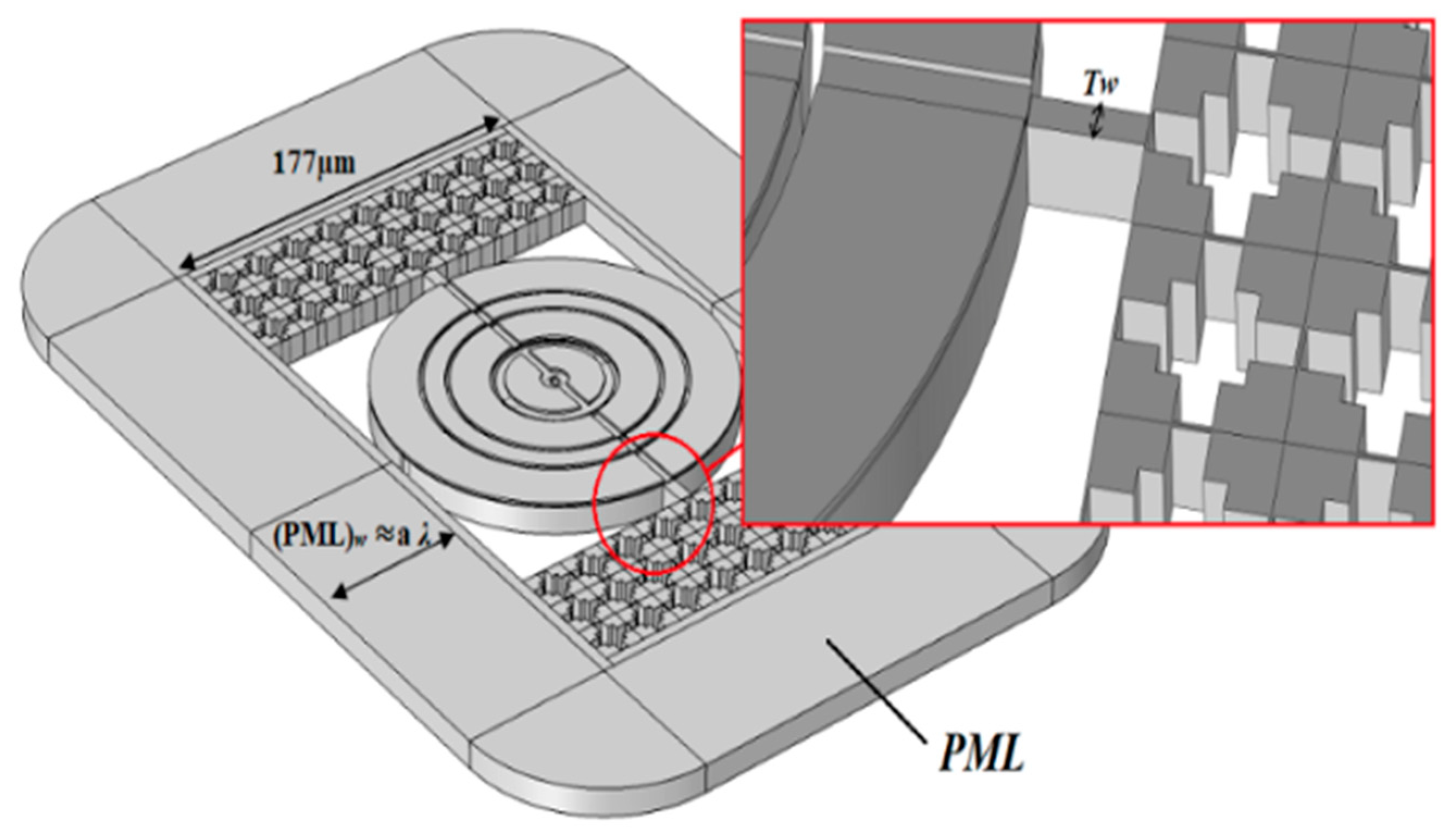
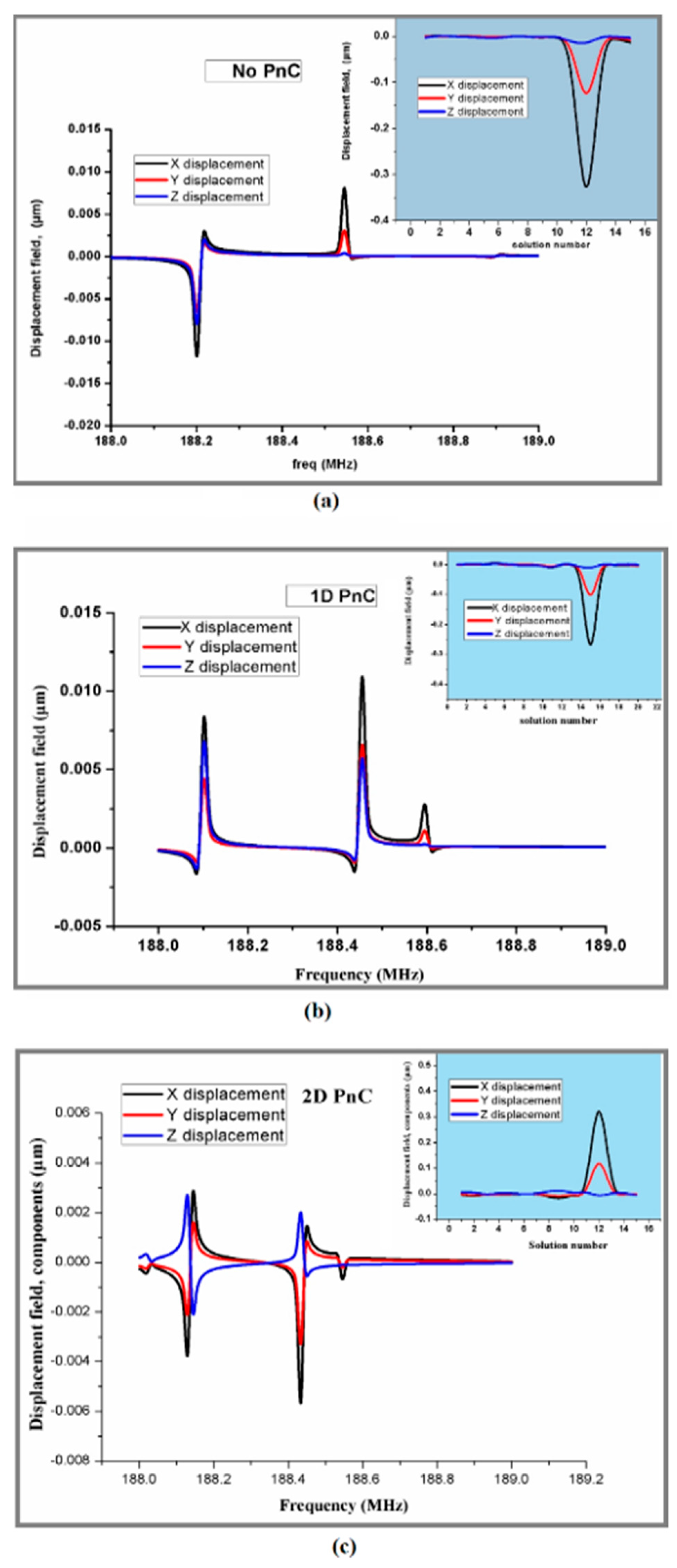
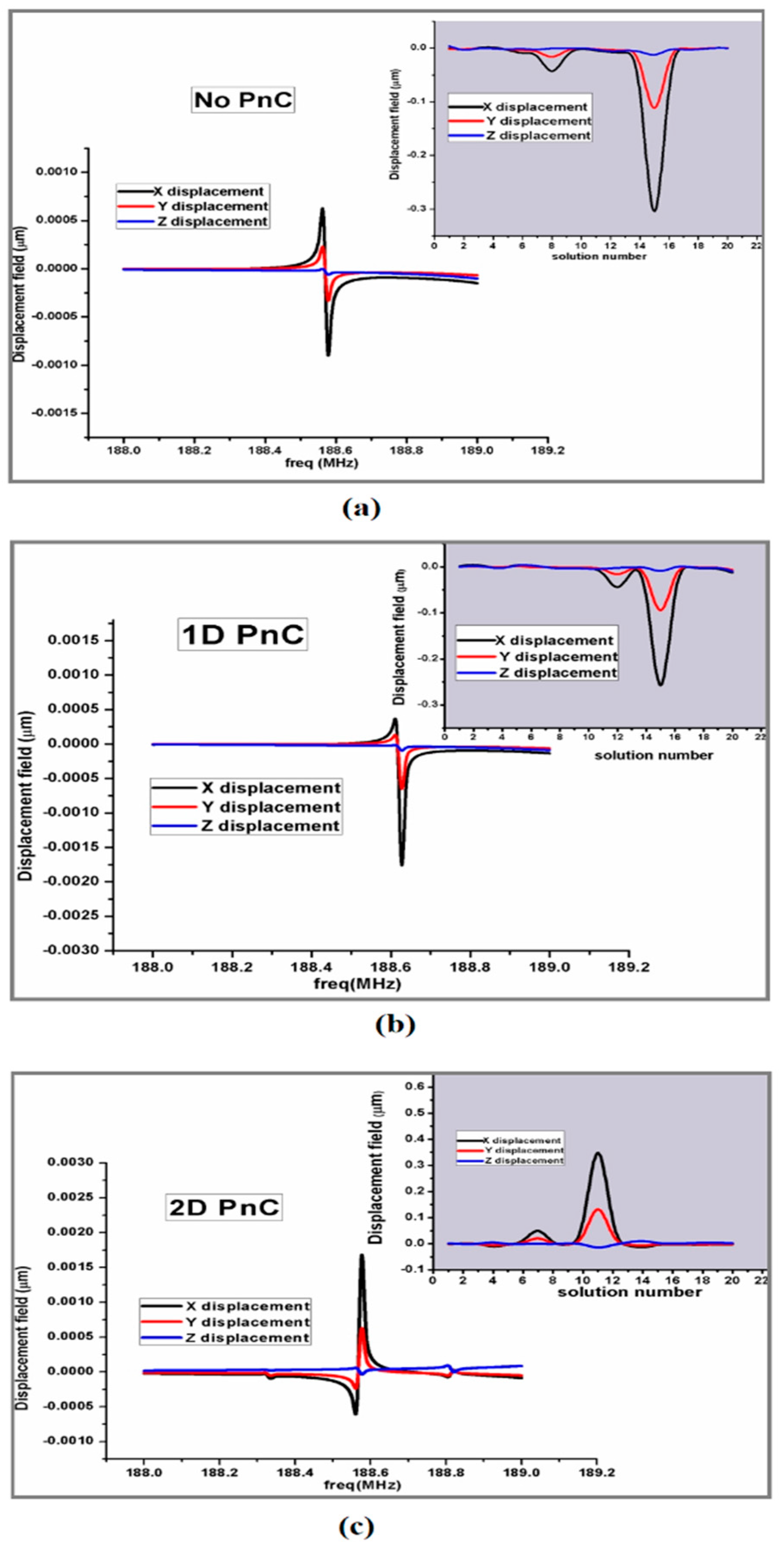
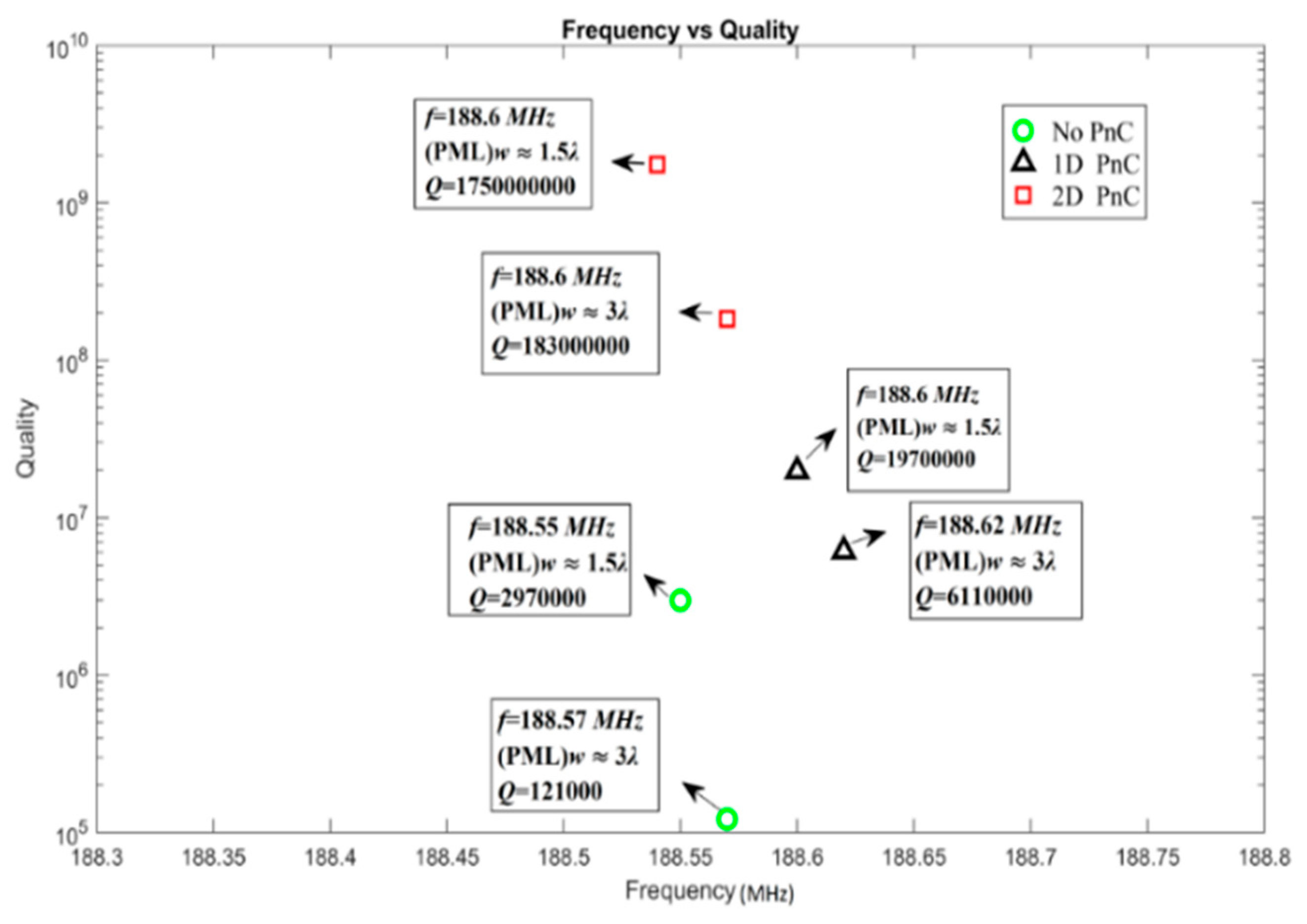
| Rectangle Hole (µm2) | Square Hole (µm2) | Maximum Bandgap (MHz) | (fα)si |
|---|---|---|---|
| 18 × 4 | 9.2 × 9.2 | 75–184 | 0.542 |
| 17 × 5 | 9 × 9 | 103.8–195.5 | 0.511 |
| 16 × 6 | 8.8 × 8.8 | 121–192.5 | 0.481 |
| Medium/Materials | Parameters |
|---|---|
| Silicon (Si) | Density (ρ) = 2330 kg/m3 |
| Aluminum Nitride (AIN) | Density (ρ) = 3300 kg/m3 Relative permittivity (ε) = 9 Poisson’s ratio (ν) = 0.24 Young’s Modulus (E) = 320 Gpa |
| Aluminum (Al) | Density (ρ) = 2700 kg/m3 Young’s Modulus (E) = 70 Gpa Poisson’s ratio (ν) = 0.35 Electrical conductivity (σ) = 35.5 × 106 S/m Coefficient of thermal expansion (α) = 23.1 × 10−6/K Heat capacity (Cp) = 904 J/Kg K Thermal conductivity (κ) = 237 W/mK |
| Structure | Frequency (MHz) | PML Width (λ ≈ 45 µm) | Quality |
|---|---|---|---|
| Without PnC | 188.55 | 1.5λ | 2970,000 |
| 188.57 | 3λ | 121,000 | |
| With 1D PnC | 188.6 | 1.5λ | 19,700,000 |
| 188.62 | 3λ | 6,110,000 | |
| With 2D PnC | 188.6 | 1.5λ | 1,750,000,000 |
| 188.6 | 3λ | 183,000,000 |
© 2019 by the authors. Licensee MDPI, Basel, Switzerland. This article is an open access article distributed under the terms and conditions of the Creative Commons Attribution (CC BY) license (http://creativecommons.org/licenses/by/4.0/).
Share and Cite
Khan, M.A.; Bao, J.-F.; Bao, F.-H.; Zhou, X. Concentric Split Aluminum with Silicon-Aluminum Nitride Annular Rings Resonators. Micromachines 2019, 10, 296. https://doi.org/10.3390/mi10050296
Khan MA, Bao J-F, Bao F-H, Zhou X. Concentric Split Aluminum with Silicon-Aluminum Nitride Annular Rings Resonators. Micromachines. 2019; 10(5):296. https://doi.org/10.3390/mi10050296
Chicago/Turabian StyleKhan, Muhammad Ammar, Jing-Fu Bao, Fei-Hong Bao, and Xin Zhou. 2019. "Concentric Split Aluminum with Silicon-Aluminum Nitride Annular Rings Resonators" Micromachines 10, no. 5: 296. https://doi.org/10.3390/mi10050296
APA StyleKhan, M. A., Bao, J.-F., Bao, F.-H., & Zhou, X. (2019). Concentric Split Aluminum with Silicon-Aluminum Nitride Annular Rings Resonators. Micromachines, 10(5), 296. https://doi.org/10.3390/mi10050296






